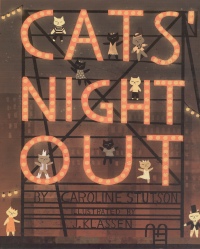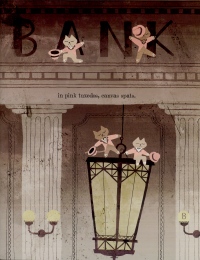| ________________
CM . . .
. Volume XVII Number 19. . . .January 21, 2011 
 |
Cats' Night Out.
Caroline Stutson. Illustrated by J. Klassen.
New York, NY: Simon & Schuster (Distributed in Canada by Simon & Schuster Canada), 2010.
32 pp., hardcover, $19.99.
ISBN 978-1-4169-4005-0.
Subject Headings:
Stories in rhyme.
Cats-Fiction.
Dance-Fiction.
City and town life-Fiction.
Kindergarten-grade 4 / Ages 5-9.
Review by Keith McPherson.
**** /4
|
| |
|

excerpt:
Eight cats tap…tip bowler hats
in pink tuxedos, canvas spats.
Ten cats line-dance, keep the beat
in rhinestones boots on easy street.
In the city,
windows light.
How many cats
will dance tonight?
In Cats' Night Out, the setting sun draws two cats out to samba on a city roof to the music that drifts up from the shadowy Easy Street below. Soon this duo is joined by two more pairs of cats who boogie and rock to the music, and these are then joined by three pairs of tangoing cats and four pairs of tapping cats. The numbers of dancing cats grow by twos until a hundred cats are dancing atop the city. Alas, the humans sleeping in the nearby apartments can't stand the cats' growing dancing repertoire. Eventually, the people lean out their windows and shriek, "Cut it out!... no more dancing on Easy Street!"
 Cats' Night Out is a visual and auditory delight and is successful on a wide variety of levels. In this review, I explore six of this book's more prominent strengths. Cats' Night Out is a visual and auditory delight and is successful on a wide variety of levels. In this review, I explore six of this book's more prominent strengths.
The first and most obvious strength of Cats' Night Out is that the text is very rhythmic and lyrical and thus easy to listen to and read. With little effort, young children can hear and repeat the story's strong rhyme, and ESL children can easily obtain and chant out the predictable rhythm of the poetic text. Aside from correctly pronouncing the names of the dances mentioned in the book (and understanding the differences between dance moves), the average grade two child could read this book independently by the end of the school year.
Second, the rhythm of the text supports the musical aspects of the story and captures the rhythm of the different types of 'catty' dances. For example, short words are used to echo the staccato rhythm of eight tap dancing cats, whereas the sentence "round and round, they hop, skip, hop" conveys the rhythm of the polka danced by the 18 cats.
Third, the sumptuous images effectively reflect the mood of the city and the movement of the dancing cats. For instance, the browns, beiges and black colours of the nighttime images reflect the warm and almost sultry mood of a sleeping city, whereas the organic lines of the cats and the placement of their limbs visibly reflect the motions and moves indicative of the cats' dances (e.g., cats have one leg bent and up high when polkaing, and both feet low and lightly touching when dancing the samba). Combined, these images evoke a rich texture of mood and movement.
Fourth, the author uses language effectively to develop tension, and she unconsciously and repetitively encourage readers to use prediction as a reading strategy. Every third page, the dancing cats are interrupted with the author's asking readers the question, "How many cats will dance tonight?" This question encourages readers to predict how many cats will join the dance, as well as encouraging them to predict what might happen with so many cats dancing on people's rooftops, clotheslines, air ducts, etc.
A fifth reason for the success of this book has to do with a clever visual 'Where's Waldo?" type of search built into most double page spreads. For every number of 'paired' dancing cats, the illustrator has hidden the equivalent natural number in the illustration (e.g., 2, 4, 6, 8…). Most numbers are relatively easy to find, but, as the numbers increased, I found the degree of difficulty in finding the numbers also increased. I found 18 very difficult to find, and number 14 was exceptionally difficult to locate (be persistent; it will show itself eventually).
And sixth, unlike the large number of 1,2,3 counting books found in libraries and bookstores, this one introduces and/or reinforces the concept of counting by twos. Parents and teachers can use Cats' Night Out to help children recognize the increasing pattern of two by having children count the number of cats on each page before reading the text.
Other aspects that make Cats' Night Out a very clever and engaging book is that, a) the back cover is a reversed image of the front cover (teachers can use these images to explore the characteristics of flips and how they differ from turns and slides), b) children are introduced to the names of 11 different type of dances (parents and teachers can use this as a springboard into exploring the differences in musical beat through dance and music), and c) the illustrator uses color, line, and tone to effectively bring attention to detail, delineate between organic and inorganic elements, and define shape and space (this could be used with older children exploring illustrative design elements).
One drawback of this otherwise outstanding picture book is that the dark tones of the illustrations sometimes make the text hard to read in low light and in situations where a teacher wants a large group to follow along with the text. For example, when reading this to my own children, I missed the text above the four cats on page five, and instead, I inadvertently skipped to the text on page six. I recommend teachers and parents read this book once through to themselves before reading it to their children.
Cats' Night Out is as much a sensory delight to the eyes and ears as chocolate is to the nose and mouth. You and your children will find yourself being carried along by the rolling and rocking rhythms, feasting upon the sumptuous settings and cool-cat dance moves, and searching for that elusive number fourteen. A must-have for anyone who derives pleasure from a joyful toe tapping read.
Highly Recommended.
Keith McPherson has been a primary and elementary teacher and teacher-librarian in BC since 1984 and is currently a lecturer for the Department of Language and Literacy Education at the University of British Columbia in Vancouver, BC.
Editor's Note: Cats' Night Out was the recipient of the 2010 Governor General's Literary Award for Illustration.

To comment
on this title or this review, send mail to cm@umanitoba.ca.
Copyright © the Manitoba Library Association. Reproduction for personal
use is permitted only if this copyright notice is maintained. Any
other reproduction is prohibited without permission.
NEXT REVIEW |
TABLE OF CONTENTS FOR THIS ISSUE
- January 21, 2011.
AUTHORS |
TITLES |
MEDIA REVIEWS |
PROFILES |
BACK ISSUES |
SEARCH |
CMARCHIVE |
HOME |

 Cats' Night Out is a visual and auditory delight and is successful on a wide variety of levels. In this review, I explore six of this book's more prominent strengths.
Cats' Night Out is a visual and auditory delight and is successful on a wide variety of levels. In this review, I explore six of this book's more prominent strengths.